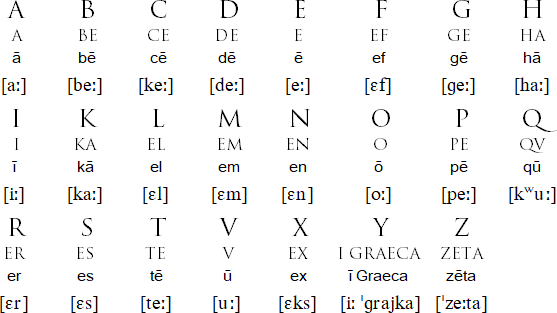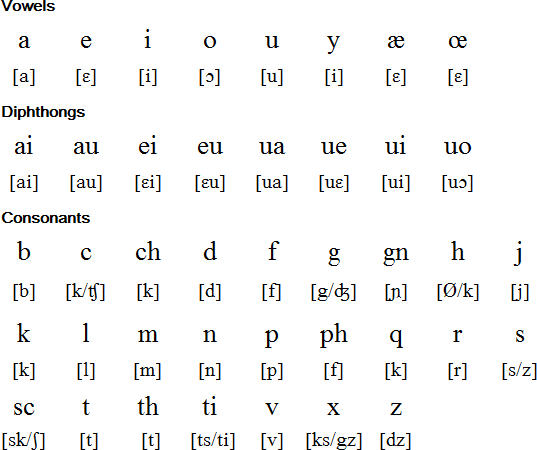In the 5th century BC, Latin was just one of many Italic languages spoken in central Italy. Latin was the language of the area known as Latium (modern Lazio), and Rome was one of the towns of Latium. The earliest known inscriptions in Latin date from the 6th century BC and were written using an alphabet adapted from the Etruscan alphabet.
Rome gradually expanded its influence over other parts of Italy and then over other parts of Europe. Eventually the Roman Empire stretched across a wide swathe of Europe, North Africa and the Middle East. Latin was used throughout the empire as the language of law, administration and increasingly as the language of everyday life. Literacy was common among Roman citizens and the works of great Latin authors were read by many.
Meanwhile in the eastern Mediterranean, Greek remained the lingua franca and well-educated Romans were familiar with both languages. In fact the earliest surviving examples of Latin literature are Latin translations of Greek plays, and Cato's farming manual, which dates from 150 BC.
The language used in much early Latin literature, classical Latin, differed in many ways from colloquial spoken Latin, known as vulgar Latin, though some writers, including Cicero and Petronius, used vulgar Latin in their work. Over the centuries the spoken varieties of Latin continued to move away from the literary standard and eventually evolved into the modern Italic/Romance languages (Italian, French, Spanish, Portuguese, Romanian, Catalan, etc).
Even after the collapse of the western Roman Empire in 476 AD, Latin continued to be used as a literary language throughout western and central Europe. An enormous quantity of medieval Latin literature was produced in a variety of different styles ranging from the scholarly works of Irish and Anglo-Saxon writers to simple tales and sermons for a wider audience.
During the 15th century, Latin began to lose its dominant position as the main language of scholarship and religion throughout Europe. It was largely replaced by written versions of the vernacular languages of Europe, many of which are descendants of Latin or have been heavily influenced by it.
Modern Latin was used by the Roman Catholic Church until the mid 20th century and is still used to some extent, particularly in the Vatican City, where it is one of the official languages. Latin terminology is used extensively by biologists, palaeontologists and other scientists to name species and specimens, and also by doctors and lawyers.
A few schools teach Classical Latin as a spoken language, and there are currently maybe 100 or so people who speak it fluently.

Hear the Classical Latin alphabet
There were no lower case letters, I and V could be used as both vowels and consonants, and K, Y and Z were used only for writing words of Greek origin.
The letters J, U and W were added to the alphabet at a later stage to write languages other than Latin.
J is a variant of I and was first used during the 16th century by Petrus Ramus.
U is a variant of V. In Latin the /u/ sound was written with the letter v, e.g. IVLIVS (Julius).
W was originally a doubled v (vv) and was first used by scribes writing Old English during the 7th century AD, however the Runic letter Wynn (Ƿ) was more commonly used to write the /w/ sound. After the Norman Conquest the letter W became more popular and had replaced Wynn by 1300.
More information about the origins of the Latin letters
http://en.wikipedia.org/wiki/A


Information about the pronunciation of Classical and Ecclesiastical Latin:
http://www.orbilat.com/Languages/Latin/Grammar/Latin-Pronunciation-Syllable-Accent.html
http://www.canticanova.com/latin_pron.htm
Download alphabet charts for Latin (Excel)
More information about the Latin alphabet

Opnēs hemones decnotāti et iouesi louberoi et parēs gnāscontor, rationes et comscientiās particapes sont, quibos enter sēd comcordiās studēōd agontinom est.
Translated by Giorgio Nagy
Omnes homines dignitate et iure liberi et pares nascuntur, rationis et conscientiae participes sunt, quibus inter se concordiae studio est agendum.
Listen to a recording of this text with Classical Latin pronunciation by Connor Ferguson
Hear another recording of this text with Classical Latin pronunciation by Matthew Leigh Embleton
Omne homnes nascuntu liberi e pares dignitat e jure, sunt da rationis e conscientiae, e agendu inter spiritu de fraternitat.
/ɔ́mnes ɔ́ːmɪnes náskʊnt líːβeri eð ͜ eku̯áːles ɪn dɪɲɲɪtáːte ed ͜ deréktos. sʊ́nt dotáːti de ratsʲóːne eð ͜ áːnɪma ed ͜ déːβent aɣíːre ɪnter séː komo fráːtres/
Hear another recording of this text by Matthew Leigh Embleton
Translation by Matthew Leigh Embleton
All human beings are born free and equal in dignity and rights. They are endowed with reason and conscience and should act towards one another in a spirit of brotherhood.
(Article 1 of the Universal Declaration of Human Rights)
Latin alphabet | Latin language | Phrases | Numbers | Time | Tower of Babel | Articles | Links | Learning materials
Latin language resources on Amazon
Information about Latin
http://en.wikipedia.org/wiki/Latin
http://www.ruf.rice.edu/~kemmer/Words04/structure/latin.html
Online Latin lessons and other learning resources
http://www.orbilat.com/Languages/Latin/
https://www.latinum.org.uk/beginner
https://www.nationalarchives.gov.uk/latin/stage-1-latin/lessons/
https://www.nationalarchives.gov.uk/latin/
http://learn101.org/latin.php
https://www.languagetutorial.org/learn-latin/
https://chaharrah.tv/chaharrah-depot/arthouse/latin-attachments/latin-book.pdf
http://latinum.org.uk
http://www.linneyslatinclass.com
https://www.latin-is-simple.com/en/
http://www.textkit.com
New York City Latin tutors
http://www.latintutors.net/phd-tutor/new-york-city-tutors.php
ALPHABETUM - a Unicode font
for ancient scripts, including Classical & Medieval Latin, Ancient Greek, Etruscan, Oscan, Umbrian, Faliscan, Messapic, Picene, Iberian, Celtiberian, Gothic, Runic, Old & Middle English, Hebrew, Sanskrit, Old Nordic, Ogham, Kharosthi, Glagolitic, Anatolian scripts, Phoenician, Brahmi, Imperial Aramaic, Old Turkic, Old Permic, Ugaritic, Linear B, Phaistos Disc, Meroitic, Coptic, Cypriot and Avestan.
https://www.typofonts.com/alphabetum.html
Faliscan, Latin, Oscan, South Picene, Umbrian
Languages written with the Latin alphabet
Page last modified: 09.06.24
[top]
You can support this site by Buying Me A Coffee, and if you like what you see on this page, you can use the buttons below to share it with people you know.

If you like this site and find it useful, you can support it by making a donation via PayPal or Patreon, or by contributing in other ways. Omniglot is how I make my living.
Note: all links on this site to Amazon.com, Amazon.co.uk
and Amazon.fr
are affiliate links. This means I earn a commission if you click on any of them and buy something. So by clicking on these links you can help to support this site.
[top]